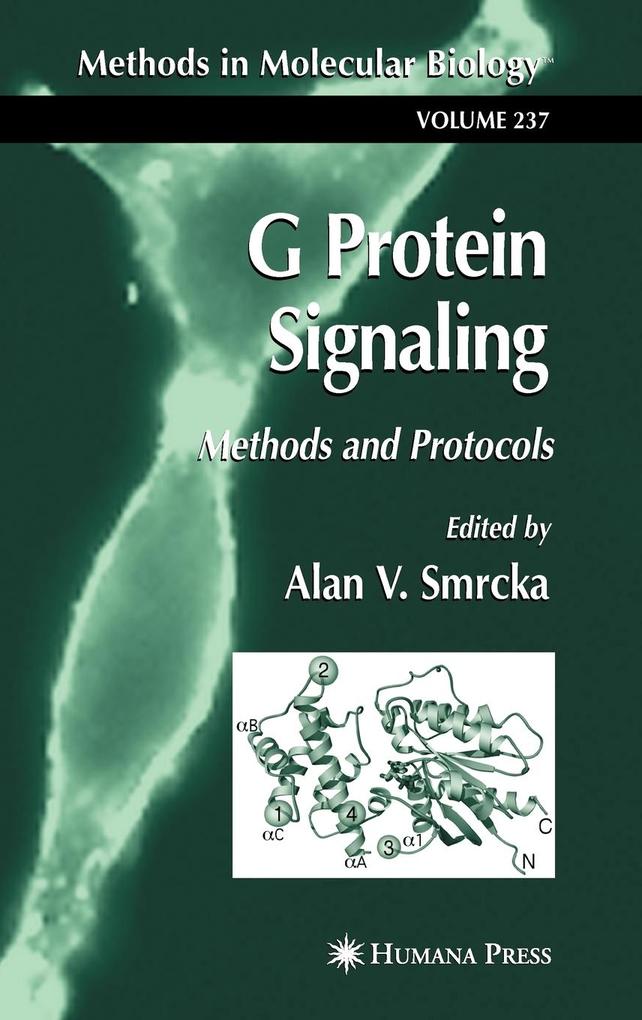G proteins and G protein-coupled receptors are ubiquitously expressed proteins that regulate a wide range of physiological processes and are consequently the targets of many pharmaceuticals. In G Protein Signaling: Methods and Protocols, leading researchers describe in detail key methods for investigating G protein signaling from a variety of perspectives ranging from in vitro biochemistry to whole animal studies. The authors focus on the mechanisms of G protein and G protein-coupled receptor function and the roles of G protein subunits in cell biology and disease. Among the readily reproducible techniques presented are those for the purification of G proteins and effector enzymes, assays of these purified G proteins and effector enzymes, and for the study of G protein interactions with effectors in intact cells. Additional methods are provided for assaying G protein-coupled receptor structure, function, and localization, for studying the physiological roles for endogenous G proteins, and for examining lipid and phosphate modifications of RGS proteins. Each fully tested protocol includes a background introduction explaining the principle behind the technique, equipment and reagent lists, tips on troubleshooting and avoiding known pitfalls, and, where needed, a discussion of the interpretation and use of results.
Comprehensive and highly practical, G Protein Signaling: Methods and Protocols offers novice and expert researchers alike an array of cutting-edge tools to illuminate the roles of G protein and G protein-coupled receptors, as well as a better understanding of their action with drugs, neurotransmitters, and sensory stimuli.
Inhaltsverzeichnis
Purification of G Protein Subunits and G Protein Effectors. - Purification of Recombinant G Protein ? Subunits from Escherichia coli. - Purification of G Protein Subunits from Sf9 Insect Cells Using Hexahistidine-Tagged ? and ? ? Subunits. - Expression and Purification of Soluble Adenylyl Cyclase from Escherichia coli. - Purification of Phospholipase C ? and Phospholipase C ? from Sf9 Cells. - Assays for G Protein Dependent Effector Activation In Vitro. - Assay for G Protein-Dependent Activation of Phospholipase C ? Using Purified Protein Components. - Assays of Recombinant Adenylyl Cyclases Expressed in Sf9 Cells. - Assays For G Protein-Coupled Receptor-Mediated and G Protein Subunit-Mediated Effector Activation in Intact Cells. - Measurement of G Protein-Coupled Receptor-Stimulated Phospholipase D Activity in Intact Cells. - Analysis of G Protein-Mediated Activation of Phospholipase C in Cultured Cells. - Receptor Mechanisms, Activity, and Localization. - Intensive Mutational Analysis of G Protein-Coupled Receptors in Yeast. - Green Fluorescent Protein-Tagged ? -Arrestin Translocation as a Measure of G Protein-Coupled Receptor Activation. - Detection of G Protein-Coupled Receptors by Immunofluorescence Microscopy. - Assay of G Protein-Coupled Receptor Activation of G Proteins in Native Cell Membranes Using [35S]GTP? S Binding. - Analysis of the Coupling of G12/13 to G Protein-Coupled Receptors Using a Luciferase Reporter Assay. - Disruption of Endogenous G Protein-Signaling Systems to Understand the Role of G Protein Subunits in Intact Systems. - Selective Inhibition of G Protein-Mediated Pathways Using RGS Domains. - Ribozymes as Tools for Suppression of G Protein ? Subunits. - In Vivo Adenoviral-Mediated Gene Transfer of the ? ARKct to Study the Role of G? ? in ArterialRestenosis. - Posttranslational Modifications of Regulators of G Protein Signaling. - Analysis of RGS Protein Palmitoylation. - Methods for Measuring RGS Protein Phosphorylation by G Protein-Regulated Kinases. - Use of Gfp-Tagged G Proteins and Effectors in Intact Cells. - The Use of Green Fluorescent Proteins to View Association Between Phospholipase C? and G Protein Subunits in Cells. - Cellular Localization of GFP-Tagged ? Subunits.
